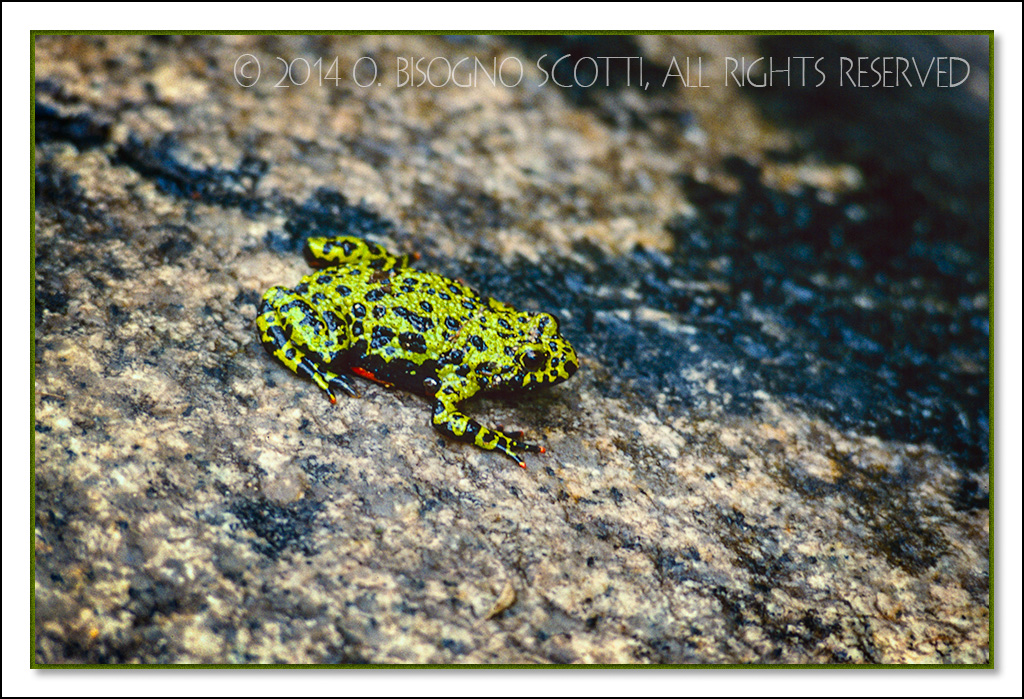Oriental Fire-Bellied Toad

Oriental Fire-Bellied Toad (Bombina orientalis) – Seoraksan National Park and UNESCO Biosphere Reserve, Republic of Korea
My brush with the poisonous Oriental Fire-Bellied Toad: Okay, so they’re are not the most dangerous amphibian in the world. They are only 2″ long, secrete a mild toxin ( you might want to wash your hands after holding one), are kept as pets by many Korean children, eats small aquatic arthropods, will pose stoically for photographers long enough so they can use a tripod, and is actually a frog. I’m just saying…with a name like Oriental fire-bellied toad, I had my guard up!
Copyright 2014 O. Bisogno Scotti, All Rights Reserved
Nikon N6006 SLR, Nikkor AF Zoom-NIKKOR 80-200mm f-2.8D ED, exposure: f/5.6, 1/8 sec., ISO 25, program mode: Aperture Priority, film: Kodak Kodachrome 25 35mm color transparency film, Mup mode, Manfrotto 3221 with Manfrotto 3265 pistol grip ball head, Nikon MC-20 remote cable, Plustek OpticFilm 7600i Ai, 35 mm film scanner, LaserSoft Imaging SilverFast 8 scanner software

lalocabruja. Thanks for visiting Blog-Bisogno.com and being the first to like my image “Oriental Fire-Bellied Toad”.
LikeLike
marktoner1. Thanks for liking my image “Oriental Fire-Bellied Toad”.
LikeLike
amandalyle1986. I thought it was time to take ” “Oriental Fire-Bellied Toad” out of the file cabinet I store all my film in and show him to the world. What an amazing little creature! Thanks for liking him.
LikeLike
My kids like this one! I do too, of course. I’d love to get back to SE Asia one day.
LikeLiked by 1 person
I’m glad your kids liked it! Where did you go and when? I went to Korea in Spring of 1994.
LikeLike
Malaysia, Thailand, Singapore, China — ’97 and ’98. Hoping to take the kids over when they’re older. (And we might be able to afford air fare for six. Ouch.)
LikeLiked by 1 person
Violet’s Veg*n e-comics. Thank you for stopping by Blog-Bisogno.com and liking my image “Oriental Fire-Bellied Toad”.
LikeLike
Hi Dina. Thanks for liking “Oriental Fire-Bellied Toad”. It was one of many delightful and unexpected things that happened during my visit to Korea.
LikeLike
Nature’s Child. The Oriental Fire-Bellied Toad may be saved from extinction by Seoraksan National Park also being designated a UNESCO Biosphere Reserve.
LikeLiked by 1 person
marcus dilano. I’m glad I made this capture. It’s probably the first and last time I will ever see an Oriental Fire-Bellied Toad. Thanks for liking.
LikeLike
Shannon. Thanks for liking “Oriental Fire-Bellied Toad” I don’t care if Korean grade school children keep them as pets. I still applaud my bravery for getting this close (even with a 200mm lens)! 🙂
LikeLike
throughopenlens. Thanks for visiting Blog-Bisogno.com and liking my image “Oriental Fire-Bellied Toad”.
LikeLike
I love the colours on this frog they just pop they are sharp, crisp, making it look alive, I can see the texture of it’s skin
LikeLiked by 1 person
For all the things you have mentioned, the credit must go to Kodachrome 64 transparency film, an extremely sharp and realistically saturated film that is no longer available. It was also the hardest film to use providing almost no leeway for exposure. More than 1/3 stop off on the plus or minus side and in the trashcan it went!
LikeLiked by 1 person
Wow I am glad that back in the film days I only did black and white, I loved that colour didn’t get in the way of the object I was capturing
LikeLiked by 1 person
I know. I was probably shooting 90% b&w in the film era. For me, It was about control. With b&w, I was able maintain control from capture to print. Color had to be handed off to a lab for developing and printing. When digital arrived, that all changed.
I learned to love color (It wasn’t hard).
LikeLiked by 1 person
sukiyama02. Thanks for liking my one and only shot of an Oriental Fire-Bellied Toad.
LikeLike
I can see why you were trembling in your boots when you came upon this dangerous creature!
LikeLiked by 2 people
I have nerves of steel!
LikeLiked by 2 people